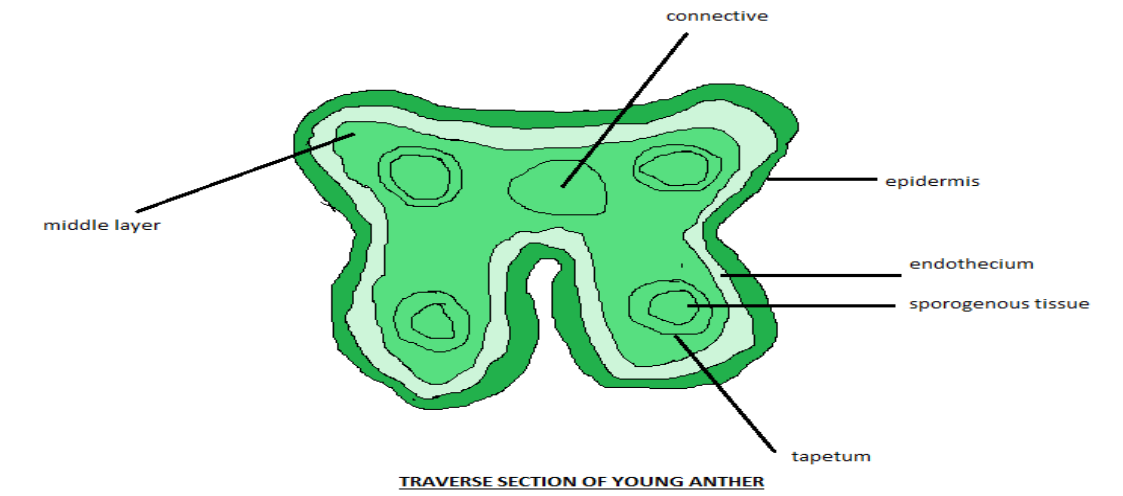
Answer
465.6k+ views
Hint: Anther has a four-sided structure that consists of four microsporangia located at each lobe. Anther produces pollen and it is the integral part of the flower’s structure.
Complete step by step answer:
T.S of young anther
It is a four-sided, multicellular structure. A young anther has a homogenous mass of hypodermal cells that is surrounded by a layer of epidermis.
In each corner, develop one or more archesporial initials.
These initials then divide by a periclinal wall into outer primary parietal cell and inner primary sporogenous cell.
Primary parietal cell divides periclinally as well as anticlinally and they form 3 to 5 concentric layers of the cells.
Anther consists of microsporangia and each microsporangia contains a layer of epidermal cells
Below the epidermal layer, endothecium exists that is radially elongated.
The innermost layer of the cell is called a tapetum. Tapetum is very nutritive in function. It lies below the middle layers. These middle layers are the flattened and crushed parenchymatous cells.
Pollen grains develop from the sporogenous tissue.
Some cells form from the procambial strand in the centre of anther.

Note:
Tapetum is the innermost layer that lies in anther. It helps in supplying nutrition and enzymes that are required for pollen maturation. It is a source of precursor for pollen coat. Parenchymatous cells which are the middle layer help in the storage, photosynthesis and gaseous exchange in the plants.
Complete step by step answer:
T.S of young anther
It is a four-sided, multicellular structure. A young anther has a homogenous mass of hypodermal cells that is surrounded by a layer of epidermis.
In each corner, develop one or more archesporial initials.
These initials then divide by a periclinal wall into outer primary parietal cell and inner primary sporogenous cell.
Primary parietal cell divides periclinally as well as anticlinally and they form 3 to 5 concentric layers of the cells.
Anther consists of microsporangia and each microsporangia contains a layer of epidermal cells
Below the epidermal layer, endothecium exists that is radially elongated.
The innermost layer of the cell is called a tapetum. Tapetum is very nutritive in function. It lies below the middle layers. These middle layers are the flattened and crushed parenchymatous cells.
Pollen grains develop from the sporogenous tissue.
Some cells form from the procambial strand in the centre of anther.

Note:
Tapetum is the innermost layer that lies in anther. It helps in supplying nutrition and enzymes that are required for pollen maturation. It is a source of precursor for pollen coat. Parenchymatous cells which are the middle layer help in the storage, photosynthesis and gaseous exchange in the plants.
Recently Updated Pages
Write the IUPAC name of the given compound class 11 chemistry CBSE

Write the IUPAC name of the given compound class 11 chemistry CBSE

Write the IUPAC name of the given compound class 11 chemistry CBSE

Write the IUPAC name of the given compound class 11 chemistry CBSE

Write the IUPAC name of the given compound class 11 chemistry CBSE

Write the IUPAC name of the given compound class 11 chemistry CBSE

Trending doubts
Fill the blanks with the suitable prepositions 1 The class 9 english CBSE

How do you graph the function fx 4x class 9 maths CBSE

Which are the Top 10 Largest Countries of the World?

Which is the longest day and shortest night in the class 11 sst CBSE

What is the definite integral of zero a constant b class 12 maths CBSE

Name five important trees found in the tropical evergreen class 10 social studies CBSE

The Equation xxx + 2 is Satisfied when x is Equal to Class 10 Maths

Differentiate between homogeneous and heterogeneous class 12 chemistry CBSE

Difference between Prokaryotic cell and Eukaryotic class 11 biology CBSE




